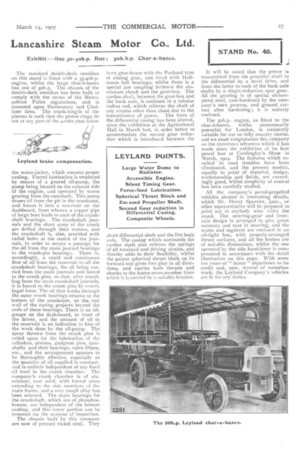Lancashire Steam Motor Co., Ltd,.
Page 27

If you've noticed an error in this article please click here to report it so we can fix it.
Exhibit:—One 30-4oh.p. Bus ; 5ob.h.p. Char-a-bancs.
The standard double-deck omnibus en this stand is fitted with a 35-4oh.p. engine, whilst the large char-a-bancs has one of 5oh.p. The chassis Of the double-deck omnibus has been built to comply with the terms of the Metropolitan Police regulations, and is mounted upon Shrewsuury and Chailiner tires. The trunk-length of the pistons is such that the piston rings do not at any part of the scroke pass below the water-jacket, which ensures proper cooling. Forced lubrication is employed by means of a geared oil-pump, the pump being located on the exhaust side of the engine, and operated by worm gearing from the camshaft. This pump draws oil from the pit in the crankcase, and forces it into a reservoir on the dashboard, from whence a copper pipe of large bore leads to each of the crankshaft bearings. The crankshaft journals and the short arms of the crank are drilled through their centres, and the crankshaft is, also, provided with radial holes at the centre of the journals, in order to secure a passage for the oil from the main journal bearings to the crank-pin bearings. There is, accordingly, a rapid and continuous flow of oil from the reservoir to all the crankshaft bearings, the oil being carried from the main journals and forced to the crank pins, so that, after travelling from the main crankshaft journals, it is forced to the crank pins by centrifugal force. The oil that works through the outer crank bearings returns to the bottom of the crankcase, as the end wall of the casing projects beyond the ends of these bearings. There is an oilgauge on the dash-board, in front of the driver, and the amount of oil in the reservoir is an indication to him of the work done by the oil-pump. The spray thrown from the crank pins is relied upon for the lubrication of the cylinders, pistons, gudgeon pins, camshafts and their bearings, valve lifters, etc., and the arrangement appears to be thoroughly effective, especially as the quantity of oil supplied is constant, and is entirely independent of any fixed oil level in the crank chamber. The company's crank chamber is of aluminium, cast solid, with lateral arms extending to the side members of ihe main frame, and a very tough alloy has been selected. The main bearings for the crankshaft, which are of phosphorbronze, are independent of the bottom casting, and this lower portion can be removed for the purpose of inspection.
The chassis built by this company are now of pressed nickel steel. They
have gear-boxes with the Panhard type of sliciing gear, and httcci with Hoffmann bail bearings, whilst there is a special jaw coupling between the aluminium clutch and the gear-box. The cardan shaft, between the gear-box and the back axle, is enclosed in a tubular radius rod, which relieves the shaft of any strains other than those due to the transmission of powet. The form of the differential casing has been altered, since the exhibition at the Agricultural Hail in March last, in order better to accommodate the second gear reduction which is introduced between the short differential shaft and the live back axle. The casing which surrounds the cardan shaft also relieves the springs of all torsional and driving strains, and thereby adds to their flexibility, whilst the patent spherical thrust block on its forward end gives free play in all directions, and carries both thrusts and shocks to the frame cross-member from which it is carried by a suitable bracket.
It will be noted that the power is transmitted from the propeller shaft to the differential by a bevel drive, and from the latter to each of the back axle shafts by a single-reduction spur gear. All the gearing is of special oil-tempered steel, case-hardened by the company's own process, and ground correct after hardening ; it is entirely enclosed.
The 5oh.p. engine, as fitted to the char-h-bancs, whilst unnecessarily powerful for London, is eminently suitable for use on hilly country routes, and we must congratulate this company on the enormous advances which it has made since the exhibition of its first petrol bus at Cordingley's Show in March, 1904. The features which resulted in road troubles have been eliminated, and the present models, equally in point of material, design, workmanship and finish, are exceed.. ingly good, whilst simplicity of control has been carefully studied.
All the company's petrol-propelled vehicles abound in interesting details, which Mr. Henry Spurrier, junr.., or other representative will be prepared to point out to anybody who visits the stand. The steering-gear and frontaxle design is arranged to give great accuracy and ease in steering, and the worm and segment are enclosed in an oil-tight box, with properly-arranged thrust surfaces, and all the brakes are of suitable dimensions, whilst the one operated by the side hand-lever is compensated in accordance with the detail illustration on this page. With some ten years of "heavy " experience to its credit and, now, several of motorbus work, the Leyland Company's vehicles are fit for any duties.
































































